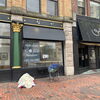Processing Your Payment
Please do not leave this page until complete. This can take a few moments.
- News
-
Editions
-
- Lists
-
Viewpoints
-
Our Events
-
Event Info
- Women's Leadership Forum 2025
- On the Road with Mainebiz in Bethel
- Health Care Forum 2025
- On The Road with Mainebiz in Greenville
- On The Road with Mainebiz in Waterville
- Small Business Forum 2025
- Outstanding Women in Business Reception 2025
- On The Road with Mainebiz in Bath
- 60 Ideas in 60 Minutes Portland 2025
- 40 Under 40 Awards Reception 2025
- On The Road with Mainebiz in Lewiston / Auburn
- 60 Ideas in 60 Minutes Bangor 2025
Award Honorees
- 2025 Business Leaders of the Year
- 2024 Women to Watch Honorees
- 2024 Business Leaders of the Year
- 2023 NextUp: 40 Under 40 Honorees
- 2023 Women to Watch Honorees
- 2023 Business Leaders of the Year
- 2022 NextUp: 40 Under 40 Honorees
- 2022 Women to Watch Honorees
- 2022 Business Leaders of the Year
-
-
Calendar
-
Biz Marketplace
- News
- Editions
- Lists
- Viewpoints
-
Our Events
Event Info
- View all Events
- Women's Leadership Forum 2025
- On the Road with Mainebiz in Bethel
- Health Care Forum 2025
- On The Road with Mainebiz in Greenville
- On The Road with Mainebiz in Waterville
- + More
Award Honorees
- 2025 Business Leaders of the Year
- 2024 Women to Watch Honorees
- 2024 Business Leaders of the Year
- 2023 NextUp: 40 Under 40 Honorees
- 2023 Women to Watch Honorees
- 2023 Business Leaders of the Year
- + More
- 2022 NextUp: 40 Under 40 Honorees
- 2022 Women to Watch Honorees
- 2022 Business Leaders of the Year
- Nomination Forms
- Calendar
- Biz Marketplace
Maine Food Insider: Tech in supermarkets seen as competitive edge
 Photo / Tim Greenway
Produce at a local food store.
Photo / Tim Greenway
Produce at a local food store.
The runup to Massachusetts-based Market Basket’s first Maine store in Biddeford in 2013 stirred up competition in Maine’s grocery business, because of that chain’s reputation for low prices and good service.
At the same time, Walmart, Target and even Amazon beefed up their food offerings, and large chains became even larger through acquisitions, like Hannaford’s purchase by Delhaize, which in turn was bought by Stop & Shop owner Royal Ahold NV.
Things haven’t gotten any easier as grocers, with already thin margins, try to woo increasingly demanding, on-the-go and fickle consumers with fresher food from local sources.
The newest gauntlet tossed into the competition is technology, which potentially could win back shoppers by personalizing their experience at the store, right down to smart shelf labels that will highlight their frequent purchases so they don’t forget the sauce for their rigatoni as they roll their buggy down the aisle, or highlight only items that are gluten free.
Tech benefits production
Indeed, experts speaking at the U.S. Chamber of Commerce’s new Chamber Technology Engagement Center TecExec series in Washington, D.C., predicted a future where shoppers could hold their smartphone up to an RFID tag on a head of lettuce and find out where and when it was picked and how long it took to get to the store.
The TecExec series will examine how technology can be deployed in many industries, but its first event focused on food. Called “Farm to Table: A Tech Story,” event panelists talked May 5 about technology’s role in agriculture, retail, distribution and the grocery industry.
“Americans are more savvy about food,” Suzanne Clark, senior executive vice president of the U.S. Chamber of Commerce, said, citing a poll that 79% of the public believes technology benefits production, and that they want to see an increased role of technology in agriculture.
Chris Hjelm, executive vice president and chief information officer at Kroger, said his store was the first to introduce the automated scanners found at checkouts in the 1970s, and it’s moving quickly to completely digitize its stores. He said Kroger is one of the world’s largest retail grocers with 2,800 stores in 35 states, 431,000 employees and 8.5 million customers.
It already is deploying sensors to manage temperature in frozen and refrigerated cases to keep food safe, a necessity under the new federal Food Safety and Modernization Act. Kroger also merged with 84.51°, a predictive analytics company named for the longitude of its headquarters in Cincinnati. It can look at customers’ habits and get food from its source to the market more quickly so there’s less spoilage and so it lasts longer in consumer homes.
“We decided we could automate the process,” said Hjelm of controlling temperature, which previously had been done manually by employees with thermometers. “We designed a network and sensor tags for temperature control. With the sensors we can fix problems before there’s a safety or food quality problem.” He added that there are hundreds of sensors in each of Kroger’s 2,800 stores.
A crystal ball for shoppers
Predictive analysis can assess customer shopping patterns, such as how long they shop and how long they’ll wait in line.
“Wait times [in line] used to be four minutes. Now they’re 30 seconds,” he said. “That’s transformed the customer mindset about Kroger as service got dramatically better as we leveraged the internet of things.”
He added that understanding customers better and providing more information and better service has improved operational excellence and customer engagement at Kroger. And that goes for the smaller stores that Kroger acquired. The chain works quickly to bring those stores up to Kroger’s technology standards.
Future technologies under consideration including putting a list of things the customer needs on his or her mobile phone and listing them in the order in which they are stocked in each aisle. Also, its system will be able to find and sort coupons based on shopping patterns.
“It’s a share-of-wallet game,” added Stuart Aitken, CEO of 84.51°. “Data is becoming so powerful and is impacting so much in so many ways.”
The event addressed other openings for technology in the food system, including drones to help farmers plant rows evenly and to identify crops that might be spoiled, as well as figuring out the shortest path to get food and distribute it to consumers, including bypassing warehouses and going direct to stores.
“People love to look at produce and new items in the store,” Hjelm said. “So we can make the experience very personal.”










Comments